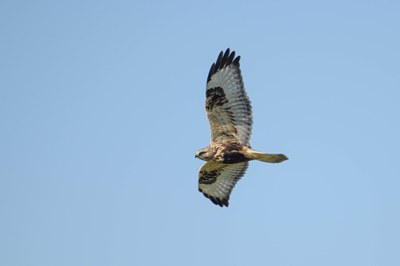
Naturalist Course
Raptors of Washington
Twenty species of raptors regularly occur in Washington State. These birds are fascinating, and their behaviors unique. Each species has many distinctive features. Birders find this group curious, and many want to see them and identify each, learning more about their behaviors. This course will help you become familiar with the eagles, hawks, falcons, vultures, and kites that make our state their homes. We will cover the characteristics, behaviors, and biology that will help you identify raptors.
- Thu, Oct 8, 2020 - Thu, Nov 5, 2020
- Committee: Seattle Naturalists Committee
- Members: $100.00 Guests: $135.00
- Availability: 11 (101 capacity)
- Cancellation & Refund Policy
We will help you learn in-depth about these remarkable birds. The course will cover all the species regularly found in Washington. The focus will be on learning techniques that will help you name them and not just on-field marks. Slides and homework will allow you to practice these skills. Right now, field trips are not possible, but we will provide detailed information on possible field trips you can do on your own, including stops and what to look for at each. We will frequently review the information to help you solidify your knowledge and feel comfortable with your new abilities.
Topics discussed during the course:
- Eagles: Golden Eagle, Bald Eagle, Osprey
- Hawks: Northern Harrier, Sharp-shinned Hawk, Cooper’s Hawk, Northern Goshawk, Red-shouldered Hawk, Broad-winged Hawk, Swainson’s Hawk, Red-tailed Hawk, Ferruginous Hawk, Rough-legged Hawk
- Falcons: Merlin, American Kestrel, Prairie Falcon, Gyrfalcon, Peregrine Falcon
- Vultures: Turkey Vulture
- Kites: White-tailed Kite
The goal is to help you learn to identify raptors, know what to look for when you see one and have a good understanding of their distribution and behavior.
Class Meeting Schedule: Thursdays, 7:00 PM - 8:30 PM (Zoom links will be sent out each week)
Thursday, October 8th: Raptor Birding Skills: Size and Shape, Behavior, Habitat, Color Pattern, & calls
Thursday, October 15th: Buteos – Begin working through these species – Review of the first lecture.
Thursday, October 22nd: Harriers, Accipiters & Review of Buteos
Thursday, October 29th: Falcons – Review of Harriers, Accipiters, and others
Thursday, November 5th: Eagles, Vultures, Kites, lots of Review
This class will use Google Classroom to provide additional information, drafts of the lectures, and recordings of the lectures. You will need a Gmail account, which is free, to access Google Classroom. All the lectures will be done over Zoom.
Instructor:
Thomas Bancroft has been a birder all his life and has a Ph.D. in Ornithology. He has birded in 48 states, several Canadian providences, and on six continents. Tom has identified more than 560 species in the United States and slightly over 2,000 worldwide. Birds have been a big part of his life, both recreationally and professionally. Their identification, ecology, behavior, and systematics were central parts of his undergraduate and graduate schooling and remain a fundamental interest. Between undergraduate and graduate school, he worked in the bird laboratory at Carnegie Museum analyzing bird banding data and helping with the banding program at Powdermill Nature Reserve.
In graduate school, he studied Scrub-Jays, Blue Jays, and Boat-tailed Grackles. While working for National Audubon, his fieldwork on wading birds and White-crowned Pigeons helped move the conservation agenda. Just before moving to Seattle, Thomas served as Chief Scientist for National Audubon, helping them integrate with the work of Birdlife International all across the Americas and advising the Department of Interior on their guidelines for wind turbines. His professional career has focused on the protection of birds, restoration of habitat and populations, and the integration of science into policy. He remains active in pushing a conservation agenda.
Tom is a Scientific Advisor to Birdnote and recently finished a 6-year appointment to Washington Audubon’s board. He currently serves as the Secretary of Washington Ornithological Society and as chair of the Naturalist Group at the Mountaineers.
Tom teaches birding classes for Eastside Audubon and helps with the Introduction to the Natural World course for the Mountaineers. He leads birding field trips for the Mountaineers, Washington Ornithological Society, and Eastside Audubon. He has been a member of Audubon since his teenage years.
This course has no scheduled activities.
You will need a computer and access to the internet. Zoom is free and can be installed on your device. We will follow all the security protocols. To access Googleclassroom, you will need a Gmail account. It is free and Google Classroom provides the chance to provide additional information, answer questions, and have exchanged between folks.
